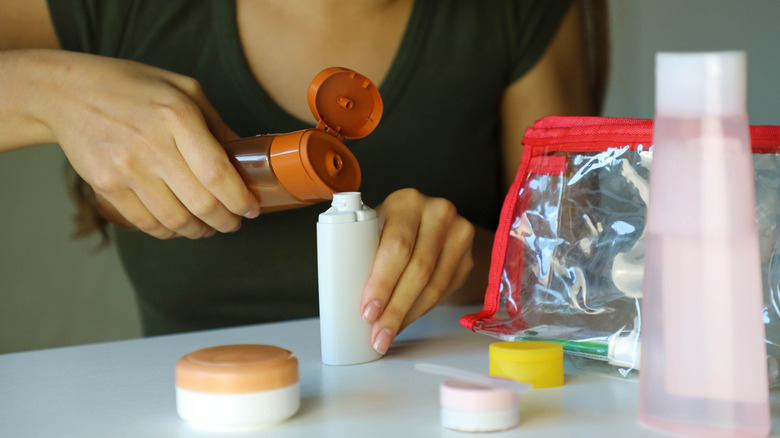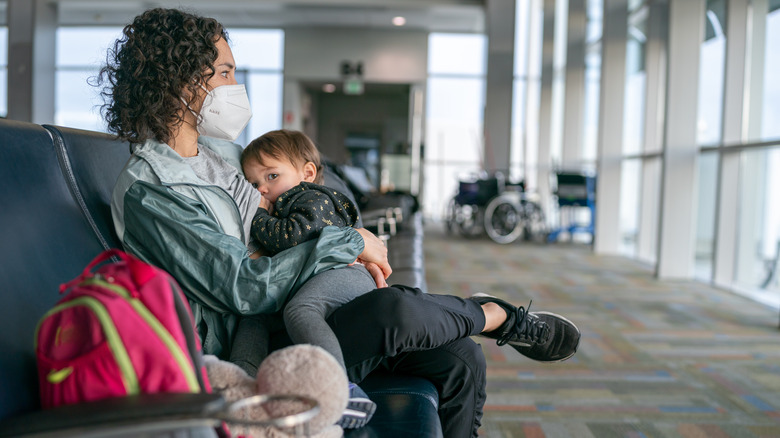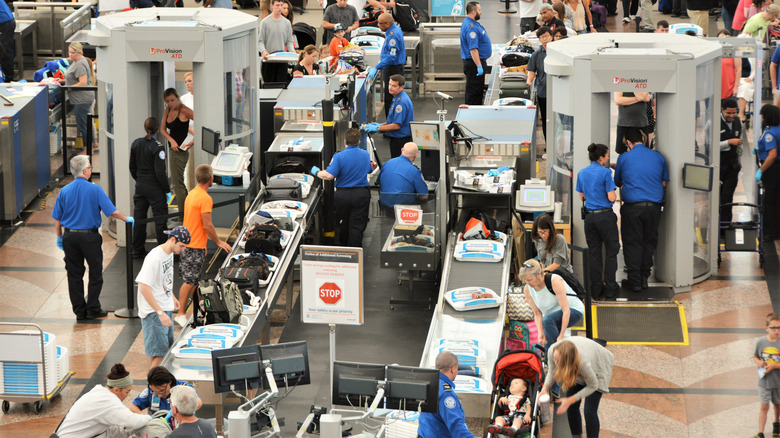Items You Might Not Know Are Exempt From TSA's 311 Liquid Rule
The airport is a lawless place, in a way that no one would bat an eye or give you a judgy glance if you decide to chug a bottle of wine at 9 in the morning. But it's also simultaneously a law-full place in that you'll get reprimanded by a disgruntled TSA officer if you ever so much as step a toe out of line — like attempt to bring said bottle to your flight. The agency, which oversees the screening of passengers and maintains order in airports, is notorious for its unwavering adherence to a long list of policies. The most infamous of these is the dreaded 3-1-1 liquid rule. But just like most rules, there are quite a few exceptions.
In August 2006, the TSA effectively banned liquids of any kind from being part of carry-ons due to a terrorist threat involving liquid explosives. A month later, it decided to lift the ban, only to impose a new, long-term guideline. To this day, passengers are required to funnel liquids, gels, aerosols, and even spreads like peanut butter, into containers no bigger than 3.4 ounces or 100 milliliters, all of which should be placed in a transparent bag. It's bad news for folks who don't have checked baggage and wish to bring larger liquid items (fancy shampoo, anyone?). However, parents carrying breast milk or formula, or travelers whose medications come in the form of liquids, are afforded some leniency.
Got milk? You'll be fine
Anything liquid deemed "medically necessary" is exempted from the 3-1-1 liquid rule, according to the TSA. This includes breastmilk, formula, and juice consumed by toddlers, along with items required to keep them cool, such as ice packs and freezer packs. Even liquid teethers and baby food in liquid form, like puree, can be brought on board without cramming them into tiny containers. Plus, should you decide to bring breast milk and formula in-flight, the TSA won't raise an eyebrow — even if your child is not with you at the time.
In the event your health condition necessitates liquid medication, the TSA generally allows passengers to bring them into the aircraft, as long as they are in "reasonable quantities" and need to be consumed mid-air or at your point of destination. This exemption isn't limited to just prescribed meds. It also extends to other items, including — but not limited to — contact lens solutions, instant hot or cold packs, and liquid vitamins.
When in doubt, you can always reach out to a TSA agent — they're just a message away. There are a number of methods to reach them prior to your scheduled departure, including social media platforms like X (formerly Twitter), Facebook, SMS, and phone calls. Agents are usually available to provide prompt replies from 8 a.m. to 6 p.m. ET.
But don't forget to inform a TSA officer
Just because there are certain items that can bypass the TSA's strict 3-1-1 liquid rule doesn't mean that officers shouldn't be notified that you're bringing them. The TSA mandates that these items be declared for further screening. "You never know what TSA agent you are going to get. You can get a really, really pleasant TSA agent, and they're not going to really give you any issues," Nikeytha Ramsey, founder and CEO of a company that manufactures breast milk and formula containers, told USA Today. "I will inform TSA, 'Hey, I do have breast milk,' or if you are a parent that has baby formula or baby food, inform them that you do have these things ... And they will take it over to either the bottle X-ray to screen it, or they will do what we call a vapor test."
The agency assures passengers that their screening procedures won't harm their liquid items. However, if you wish to do away with their intimidating scanners and machines, you can ask to opt for an alternative screening method.
These processes are a hassle, sure, but even the TSA longs for the day that they can provide travelers more leeway. "I don't think anyone is saying that the way we did things [is] the way we will do things," J. Matt Gilkeson, director of TSA's Innovation Task Force, shared with the Washington Post. "We want to be beyond where we were 20 years ago."


